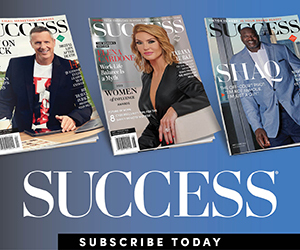
views
Quick Links
SECTIONS
- Business
- Entertainment
- Future of Work
- Health & Wellness
- Lifestyle
- Money
- Personal Development
- Professional Development
- Relationships
- Business
- Entertainment
- Future of Work
- Health & Wellness
- Lifestyle
- Money
- Personal Development
- Professional Development
- Relationships
JOIN US
- SUCCESS+
- SUCCESS Coaching
- Speakers Bureau
- SUCCESS Events
- SUCCESS Space
- Newsletter
- Daily SMS
- Subscribe
- Shop the SUCCESS Store
- SUCCESS+
- SUCCESS Coaching
- Speakers Bureau
- SUCCESS Events
- SUCCESS Space
- Newsletter
- Daily SMS
- Subscribe
- Shop the SUCCESS Store
GET IN TOUCH
CONNECT
Instagram Facebook Tiktok Linkedin Pinterest X-twitterMORE

Unlock the Latest Knowledge that Can You Help You Achieve More in Life with More Confidence
Print and Digital Options Available
BOOKMARK Share TABLE OF CONTENTS
TABLE OF CONTENTS


What could building a fort, having an imaginary tea party or even just tossing a ball with your kid in the evening mean for your work day? Quite a lot, according to a new survey of over 100 CEOs conducted by LEGOLAND New York. It showed that 68% of CEOs believe that their employees who play outside the office tend to be more creative in the workplace as well. So what’s the connection?
Play at work has gained attention in recent years for its role far beyond childhood, and on into the workplace, when tech companies especially started changing office layouts a few years ago to accommodate think spaces with everything from ping pong tables to fidgets. But the emphasis on play, including in the office, is expanding beyond the younger employees and tech companies.
“Companies are leaning into dynamic and enjoyable work environments and activities that increase employee happiness, reduce cognitive load, increase tenure and lead to higher productivity,” says Natalie Engels, principal and global work sector leader at Gensler, who designs innovative spaces for companies like Adobe. “Incorporating play and creativity used to be thought of as spaces that only Big Tech would include within their portfolio so that younger generations could have fun and create a balance within their workday. Now, it is thought of as an essential space type or activity for all generations in order to create balance and team building within their workday while at the office.”
So, whether play at work means a team kickball tournament or ideating with a doodle board, employees in a variety of industries are tapping into the power of play.
The reason for play is evolving, Engels shares. “Ten years ago, a video game room, a ping pong table, a foosball table went a long way in showing that a tech company was youthful. Now, while you may still have rooms or equipment for video games, board games, ping pong, etc., these spaces must have thoughtful purpose and work policies in place to support them,” she says. Companies are asking themselves questions like, “How do you, as a company, think about team building, enabling friendships at work, providing creative and cognitive outlets?” she adds. As more employers recognize health and well-being as a vital part of employees’ post-pandemic lives, they sometimes see play and creative spaces as ways to promote inclusivity as well, Engels explains.
“A ping pong table helps somebody escape from their work, when really what you want is something that ties people into the purpose of their work,” says Laura Gassner Otting, a success and mindset coach, bestselling author of Wonderhell: Why Success Doesn’t Feel Like it Should… and What to Do About It, among other books. Instead, she suggests something with more purpose, such as doing community service together, to create meaning rather than just moving their bodies—a demonstration of shared values, she adds.
Not all play at work is equally effective, or even fun, according to Leanne Mair, CEO of Benefactum Consulting and author of Closing the Gap: How to Include Black Women in any Gender Equity Strategy. She explains that sometimes it can feel awkward at first, such as a favorite activity she’s seen incorporating play with brainstorming—throwing a ball and sharing your idea when you catch it. “It was whimsical and it felt awkward at first, but the more each person had something to share, the more fun it was. But more than that, the ideas that were shared were innovative and the sense of competition to outdo each other increased. It was a play exercise that also had a purpose,” she says.
But, she cautions that play can create tension rather than improve creativity without the right structure. “Play can backfire, when the concept is misunderstood. As in, colleagues thinking of it as an opportunity to ‘just have fun and be silly’ rather than the bigger picture of improved communication, understanding the experiences of others and team building,” she says. “There can also be an extreme competitiveness that is unhealthy that seeps into working life and has the opposite effect.”
For some, the breakthrough is team bonding rather than a creative epiphany. For example, Beth Cooper, KNB Communications’ VP of marketing and sales shared on LinkedIn her team’s goat yoga outing, with the caption “The team that plays together, shines brighter at every endeavor.”
Adults might not think of themselves as people who “play,” at least not at first. But once they try it, they might realize how much it helps their creativity inside and outside the office. Dale Majors, co-owner of Grand Trunk, an outdoor recreation retailer, went on a six- to 12-week adventure every two years while building companies. He credits that playtime with helping him see his business more clearly and make better decisions.
“We’re not wired to work all day long without stopping, and if we don’t actively take breaks, they’ll come in the form of water cooler talk or any other escape to get the break we need to recharge and refocus on what we’re trying to accomplish,” he adds. “Especially when it comes to solving problems or creative work, our minds need time to stew and process our problems. Taking deliberate breaks to play ping pong, exercise, swing clubs on the golf simulator or even take that call while putting around on the putting green, these are all things that help me stay fresh and return my full focus to a project.”
His recommendation? Midday exercise, which he calls a “natural break” when he needs to recharge, rather than in the morning when he’s already fresh from sleeping.
Kristi Herold, CEO of JAM based in Toronto, one of the largest adult recreational sports league providers, pivoted in the pandemic to provide virtual play for companies as well as workplace culture consulting. She’s also the author of the book It Pays to Play, and she gives an example of hitting a wall during a tired work session and taking a break to play guitar. Within a few minutes, she says the “flow state” she was in helped her percolate on some ideas.
“I had a couple of thoughts that came to me that you don’t get when you’re dealing with emails or reading something,” she says. In this way, productivity and creativity can soar with play at work integration.
When the world scrambled into remote work in 2020, an onslaught of painful icebreakers and forced play came with it as companies tried to infuse company culture remotely and encourage bonding while we were all separate. This has left some scars for some who might resist the push to play with coworkers, in all senses of the word.
But, Herold says, no fun should be forced. However, there are ways to integrate play at work into company culture that genuinely make everyone want to get involved—such as the Microsoft Teams “Banter” chat constantly running in her workplace where people can make jokes and share photos from last night’s bowling outing, and those who weren’t there wonder what they missed.
For example, every day at the same time all the remote and in-person employees gather for “Huddle,” a 7-minute meeting that has a specific format, and everyone takes a turn leading. It always starts with good news and ends with something fun. In addition, she says they recently launched “houses,” like Harry Potter houses, that compete against each other in challenges. Finally, new employees are ushered in with all other employees available clapping for them. They also have a company “mayor” who changes every four months who plans the fun.
The company pays for year-round adult sports leagues for employees, which is optional as well, but Herold says they love when employees do participate because “the silos come down.”
“Someone from finance is on a team with someone from marketing is on a team with someone from HR… friendships develop…” she says. Those friendships matter back at work when, the next day after a fun practice, another teammate sees someone they played with stressed out and asks how they can help. For more traditional leaders worried it’s too much play and not enough work, Herold shares the connection with profits: “When you’re happier at work you’re going to make happier customers, which helps the bottom line,” she says.
Herold references a popular quote that workplace culture can cling to as they move toward adopting play in and outside work hours, “You can discover more about a person in an hour of play than in a year of conversation.”
Photo by G-Stock Studio/Shutterstock.com
5473 Blair Road, Suite 100
PMB 30053
Dallas, TX 75231
Copyright © 2024 SUCCESS Magazine. All rights reserved.
Unlock the Latest Knowledge that Can You Help You Achieve More in Life with More Confidence
Print and Digital Options Available
Copyright © 2024 SUCCESS Magazine. All rights reserved.
Unlock the Latest Knowledge that Can You Help You Achieve More in Life with More Confidence
Print and Digital Options Available
https://www.success.com/play-at-work/

























Comments
0 comment